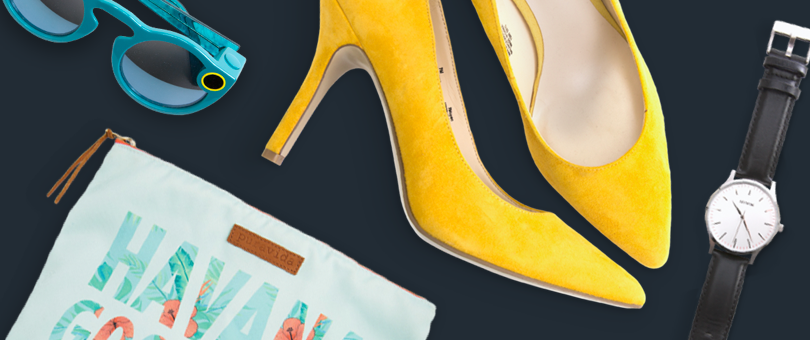2019 has arrived: a flip of the calendar so wild it might have taken three venture capitalists, two chief marketing officers, and one heck of an information technology expert to keep up.
Some of the year’s headlines may have been lost in the shuffle. Likewise, you could have missed a strategy deck (or 12). Not to worry, we have you covered. Presenting …
Our annual list of the best and most-valuable ecommerce articles as decided by you, our readers.
To determine the winners, we combined stats on traffic, social shares, time-on-page, and engagement then normalized for publication date. We also pulled out one lesson from each article to help guide you into the New Year.
1. The State of the Ecommerce Fashion Industry: Statistics, Trends & Strategy
The definition of a fashion ecommerce business can be as sweeping as fashion itself: they come in all shapes, sizes, price points, and levels of quality. But any fashion biz must share similar traits to succeed: foremost, the ability to forecast and navigate change.
It’s why we compiled the most relevant stats, trends, and strategies for online fashion retailers.
The best fashion companies operate like savvy tech start-ups, their style augmented by data, informed by market fit, and served up to customers the way they might shop for any product — whether online or off.
Most Valuable Lesson:
“According to data presented by Nosto at a recent Growing Your Online Funnel Webinar, personalization is a leading factor in ecommerce at large:
- 43% of purchases are influenced by personalized recommendations or promotions
- 75% of consumers prefer brands to personalize messaging, offers, and experiences
- 94% of companies see personalization as critical to current and future success
“By tracking user behavior, either session-by-session or by account, fashion sellers can build Netflix-like personalization into the onsite experience.
“Although this may start with recommended products — if you watched or bought this, you might like to watch or buy that — true personalization extends to the very visuals that are used to present products themselves.”
2. What Is the Future of Ecommerce in 2018 and Beyond? 10 Trends (Updated for 2019)

Pick your favorite cliche and you’d be right: “It was the best of times. It was the worst of times.” “Change is the only constant.” “Skate to where the puck is going, not where it has been.”
With bankruptcies mounting and a bear market at large, 2018 was tumultuous not just for ecommerce but commerce itself. It’s no wonder then that “What Is the Future of Ecommerce in 2018 and Beyond?” was our most-visited post of the last twelve months.
It’s also no wonder that we’re only days away from releasing a sweeping update for 2019.
Most Valuable Lesson (Forthcoming):
“Bifurcating retail — i.e., brick-and-mortar versus ecommerce — is a false dichotomy whose heyday has ended.
“Choice, not location, is retail’s greatest threat and opportunity. It’s why the future belongs neither to retail giants nor pure-play ecommerce but instead to direct-to-consumer (DTC) models often referred to as digitally native vertical brands (DNVB). Just don’t let the name fool you.”
3. Online Shopping Trends in 2018: Welcome to Ecommerce’s 11 New Realities

Setting aside buzzwords like artificial intelligence, machine learning, voice-enabled search, and online-to-offline VR, growth-minded leaders would be wise to mix three parts reality into every one part prediction.
Case in point: mobile shopping. Despite having overtaken desktop in terms of overall traffic, mobile buying has yet to establish itself as the de facto purchasing channel online. Crossing that divide is a far more pressing issue than much of the mainstream mediaspeak vying for your attention.
Most Valuable Lesson:
“A mobile-optimized checkout goes beyond a mobile-friendly (also known as, mobile-responsive) site. Instead of merely adjusting the size and layout of your page, the final steps in a shopper’s journey must make buying — not just browsing — easy.
“As mobile commerce continues to grow, businesses need to provide an integrated and seamless experience across all consumer touchpoints that makes multi-channel selling as natural as possible.”
4. John’s Crazy Socks, With $4M+ In Sales Over Just 22 Months, Is Not a Cute Story

The story of son and father entrepreneurs John and Mark Cronin was our most-shared article of 2018. Shopify Plus would love to take credit for those numbers. But we can’t.
Truth be told, the Cronins are no strangers to going viral. “But watch what you ask for,” Mark says. “You may get it.”
In addition to a clip from online journal The Mighty being viewed more than 15 million times, John’s Crazy Socks has also been featured by everyone from the BBC to Fox to Google. Amidst all the heart-warming headlines, be sure you don’t miss the real message …
Most Valuable Lesson:
“There are two sides of being a social enterprise: social and ecommerce mission,” John testified to the U.S. House of Representatives in May. “Without the social mission, we’d be just another sock store.
Without a solid ecommerce business, we would be nothing more than a cute story.
5. 12 Ways to Improve Ecommerce Site Performance & Speed for 2X Conversions

Speed isn’t only sexy; it’s imperative. We live in a time of incredible site design, beautiful ecommerce experiences that exude class and make customers remark, “I want to shop there.”
But the sword has two edges.
Often, consumers are fickle, and if your site — no matter its aesthetics — does not load quickly enough, conversions may plummet. This is our exhaustive resource on site performance and speed, specifically as it relates to helping your conversion rate.
Most Valuable Lesson:
“Perhaps more startling is the difference a second makes in ecommerce. If a site makes $100K per day:
- A one-second improvement means an additional $7K daily
- A one second delay normally equals an 11% loss in pageviews
- A one second delay also means an overall 7% drop in conversions”
6. 3PL (Third Party Logistics): Everything You Need to Find the Right Shipping Provider

If speed is sexy, logistics are decidedly not. And yet, you won’t have to look far to find shell-shocked business owners, weighed down by fulfillment issues.
Take Death Wish Coffee: once an Amazon and eBay sales star; now, a multimillion-dollar business. But when its fulfillment, shipping, and logistics broke down, the company cratered until it chose the right partner. “Everything fell apart,” CEO Mike Brown said of his company’s nadir. “It was a nightmare.”
Most Valuable Lesson:
“The big mistake (companies make) is to ask about price first. Price is one of the last things you ask. A good provider is worth its weight in gold. Reduction of errors and timely deliveries equal happy customers, and happy customers order more.”
“An extra 25 cents per order is cheap if your customers’ expectations are met, or even better exceed.”
7. Loyalty Program Examples: 25 Strategies & 100+ Stats from Ecommerce & Retail

The first loyalty programs date back to the late 18th century when American retailers were known to pass customers copper tokens that could be used toward future merchandise.
If that sounds quaint, know that the psychology of loyalty programs remain unchanged since.
Indeed, while shoppers still want the feeling of being rewarded for their patronage, the ways retailers offer their customers value have evolved dramatically. Today, the best rewards programs borrow elements from psychology, behavioral economics, and game design.
Most Valuable Lesson:
“COLLOQUY sheds light on the top reasons members abandon a loyalty program:
- Took too long to earn points or rewards: 57%
- Did not provide rewards I was interested in: 53%
- Program sent too many communications: 38%
- Communications were irrelevant: 36%”
8. Black Friday Ecommerce: 27 Ideas, Tips & Strategies to 3X-10X Holiday Sales in 2018

Tour de force. That’s the only way to describe Andrea Wahbe’s nearly 6,000-word guide to the main event of every ecommerce business’ year. With 27 strategies to choose from — 29 if you count the two “bonuses” for Black Friday contingency plans — each point includes either data or an actionable illustration from a merchant’s past success.
My recommendation is to start your Black Friday planning as soon as possible using the first two sections on (1) creating a “master strategy” and (2) focusing on “the offer.”
Most Valuable Lesson:
Chase Fisher, the CEO of Blenders, explains it like this, “You can’t go into Black Friday and put 15% off, 20% off and expect to do well. Everything comes down to your offer – it’s the one time out of the year you can lower your prices without feeling like you’re losing brand integrity.
Make sure your offer is compelling, no matter what.
9. Omni-Channel Retailing: What Is Omni-Channel Commerce, Really?

Far more than a Wikipedia-styled answer, Tommy Walker — former Editor in Chief of Shopify Plus and now Global Editor in Chief of The QuickBooks Resource Center — covers the definitions and data surrounding omni-channel retail.
Still, it’s not until halfway point, “What Omni-Channel Shopping Feels Like,” that the article truly leaves behind surface-level summaries and dives into a host of real-world examples spanning social media, onsite commerce, and brick-and-mortar retail.
Most Valuable Lesson:
“What separates this from what many businesses are doing is inviting the buyer to take actions that feel native to additional channels, so the interaction isn’t forced or contrived. When done well, buyers seamlessly transition from one channel to the next, blissfully falling deeper and deeper into the brand experience.
“As they evolve from buyer to loyal customer, your brand’s communications also deepen to accurately reflect where they are in the customer journey.
10. Omni-Channel vs Multi-Channel: What is the Difference and Why Does It Matter?

Omni-channel, multi-channel … you can talk yourself in circles parsing the difference between the two. Any ecommerce partner can offer a working definition between the two, but how to navigate both — and finding the right fit for your business — is where this guide stands out.
A deep-dive through the buying experience provided by sleep brand Leesa illustrates perfectly the impact an effective approach to selling across channels can give customers.
Most Valuable Lesson:
“Making your retail business omni-channel will take a lot of resources. Worse yet, there’s no stopping halfway. Non-functioning omni-channel technology will create the same experience as absolutely no omni-channel technology (unless you can figure out how to build it in a modular way).
“So while omni-channel would be the textbook answer, some businesses might be better served starting off with a multi-channel experience before tying them all together into an omni-channel one.”
The Best Is Yet to Come
If 2018 was any indication, 2019 is going to be a banner year for businesses on Shopify Plus. Likewise, we have some incredible things in store for our readers as well. A new look. A more curated approach. And content you’re not going to see anywhere else.
Come along with us for the ride. Happy New Year.





